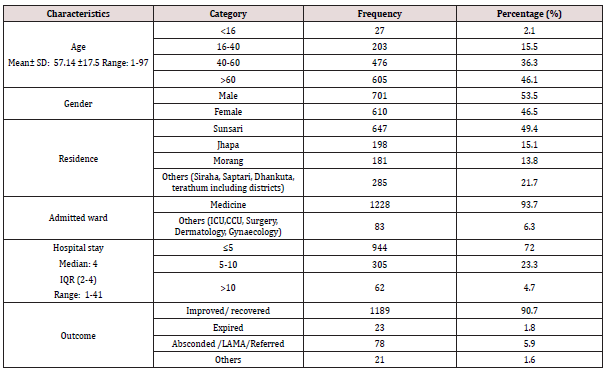Lupine Publishers| Advancements in Cardiovascular Research (ACR)
Abstract
Hypertension is a global public health issue that affects approximately 1 billion people worldwide in both developed and developing countries. It is also considered as an ‘Iceberg’ disease’ because unknown morbidity far exceeds the known morbidity. High blood pressure (BP) is ranked as the third most important risk factor for at attributable burden of disease in South Asia. With an aim to determine the profile of the hypertensive patients a retrospective cross-sectional study design was used to analyze the medical record of 1311 patients admitted with the primary diagnosis of hypertension at BPKIHS January 2005 to May 2016. The study revealed that majority (82.4%) of the patients was above 40 years of age with the mean age of 57.14 ±17.5. More than half (53.5%) of the patients were male. Almost half (49.4%) of the patients were from Sun sari district. More than 90% of the patients were admitted in medical ward. Majority (90.7%) of the patients were improved at the time of discharge.
Introduction
Hypertension is a global public health issue that affects approximately 1 billion people worldwide in both developed and developing countries [1]. It has also been described as the ‘silent killer’ because initially the disease presents with no apparent symptoms, and hence an individual can have hypertension without realizing it [2]. Hypertension is also considered as an ‘Iceberg’ disease’ because unknown morbidity far exceeds the known morbidity [3]. Hypertension is a widely recognized as a major risk factor for cardiovascular disease such as stroke and myocardial infarction, as well as for chronic kidney diseases and congestive heart failure among men and women. Hypertension accounts for approximately 50% of coronary heart disease and 67% for the cerebrovascular disease burden worldwide [4]. Globally, the overall prevalence of raised blood pressure in adults aged 18 years and over was around 22% in 2014 [5]. The global prevalence of hypertension is currently increasing and is projected to affect in excess of 500 million by 2025. The prevalence of hypertension increases with age in all populations.
It is estimated that hypertension causes 7.5 million deaths worldwide amounting to 12.8% of the total of all annual deaths [6]. High blood pressure (BP) is ranked as the third most important risk factor for attributable burden of disease in South Asia [7]. Even in Nepal, a recent study in rural Kathmandu showed that prevalence of high blood pressure has been increased by three fold in 25 years [8]. According to the latest WHO data published in May 2014 Hypertension deaths in Nepal reached 3,584 or 2.26% of total deaths [9]. The age adjusted death rate is 20.77 per 100,000 of population and ranks Nepal 51st in the world. A study done by Seow LES in Singapore among elderly residential population revealed that the rate of hypertension was associated with older age, lower education, and higher body mass index (BMI).
Objectives
The objective of this study was to determine profile of admitted hypertensive patients in BPKIHS.
Methodology
A retrospective cross sectional study design was used to study the profile of patient admitted with hypertension as primary diagnosis in different wards of BPKIHS. The study involved the analysis of medical records of patients admitted at B.P. Koirala Institute of Health Science from January 2005 to May 2016. Permission was obtained from the concerned authority. Anonymity of the subjects was maintained. The information obtained was kept confidential and used for the study purpose only. Age, sex, residence, duration of stay and outcome were analyzed using SPSS version 16. Data were presented by percentage, mean and standard deviation.
Results
A total of 1311 patients were admitted between from January 2005 to May 2016. Their age ranged from 1 year to 97 years (mean 57.14 years and SD of 17.5 years). More than half (53.5%) of the patients were male. Almost half (49.4%) of the patients were from Sun sari district followed by Jhapa and Morang and other districts. Patient stayed in the hospital for 1 day to even 41days with median duration of stay of 4 days. Of the 1311 admitted patients, majority i.e. 90.7% of the patients improved whereas 1.8% expired in the hospital. The details of findings are depicted in Table 1.
Table 1: Profile of admitted Hypertensive Patients (n=1131).

Discussion
Hypertension is now an epidemic with developing countries being heavily burdened. Over the last 20 years various studies have shown that people in economically developing countries are increasingly having high blood pressure levels with a high prevalence of hypertension. The prevalence of hypertension increases with age in all populations. Out of total 1311 patients in the present study 39.1% of the patients were more than 60 years with the mean age of 57.14 and SD of 17.5 Similar finding was seen in a study done by Humagain S and Koju R [10] among hypertensive patients which showed the mean age of 55.49±1.03 years. More than half i.e 53.5% of the patients in the present study was male. However in a study conducted by Ogunlana Mo et al [11] in south western Nigeria showed the female predominance (56.6% female). As BPKIHS being the only tertiary level health centre of the Sun sari district serving 16 districts of eastern development region almost half of the patients (49.4%) were from Sun sari district. Majority (93.7%) of the patients were admitted in a medical ward. Majority of the patients had the hospital stay of up to 5 days with the median length of stay of 4 days and ranged from 1 to 41 days. At the time of discharge majority i.e. 90.7% of the patients were improved.
Conclusion
Hypertension is a significant clinical problem. From the present study it can be concluded that it is more common in late adulthood and elderly population and male are commonly affected.
Read More Lupine Publishers Advancements in Cardiovascular Research (ACR) Click on Below Link https://lupine-publishers-cardiovascular.blogspot.com/

No comments:
Post a Comment
Note: only a member of this blog may post a comment.